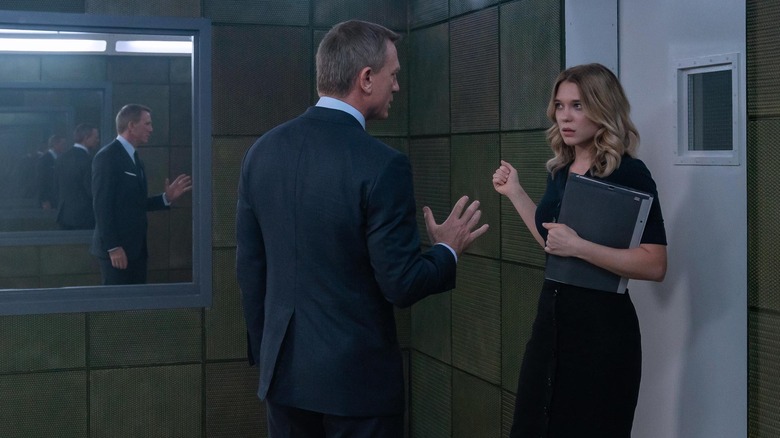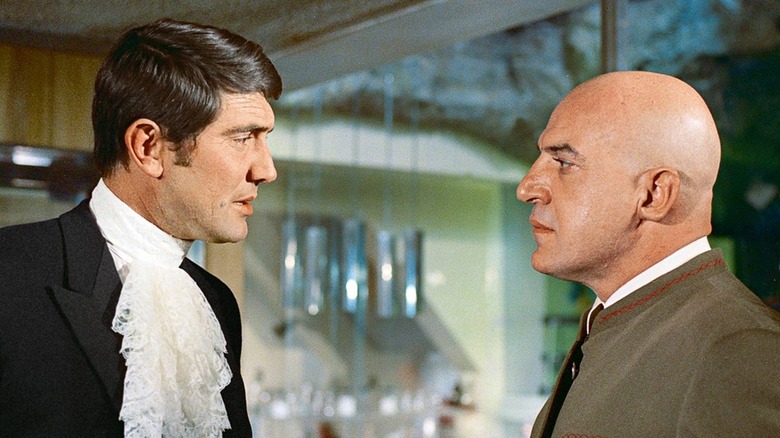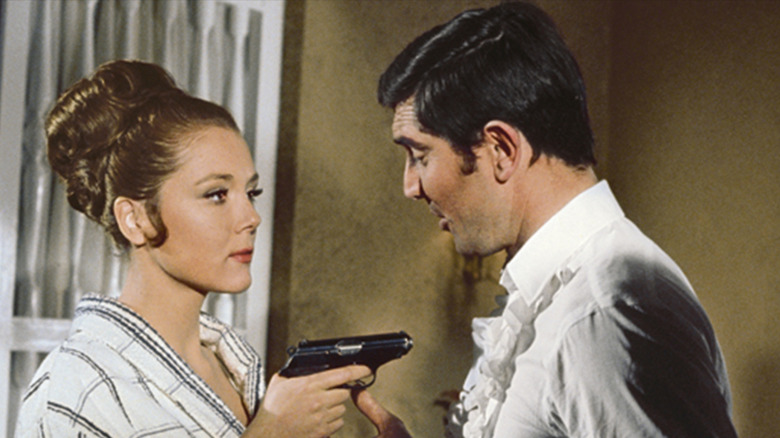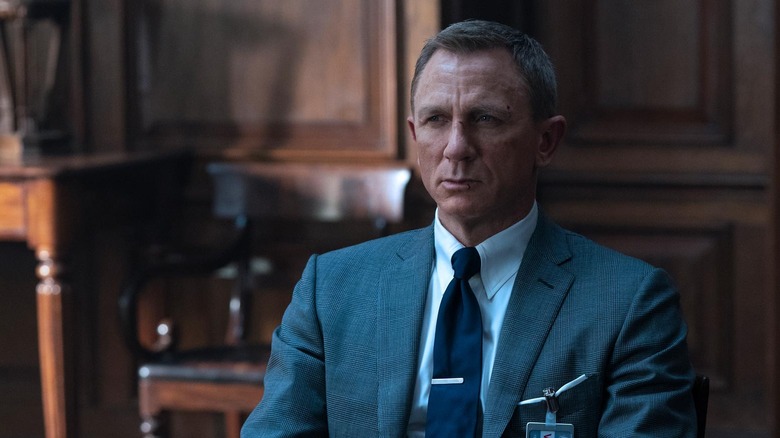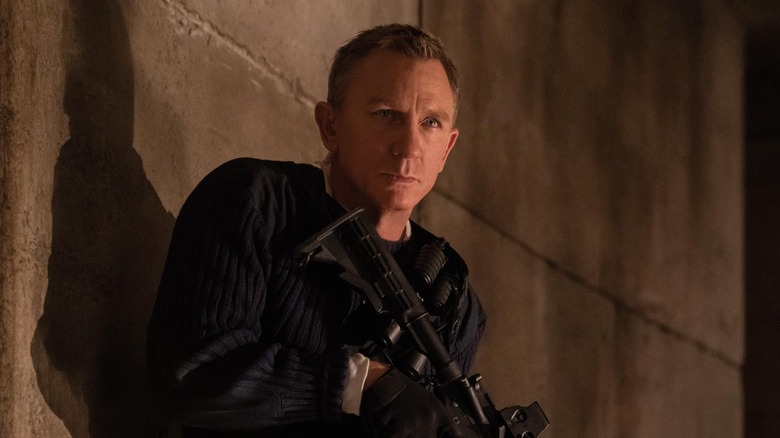No Time To Die Owes A Major Debt To Another James Bond Classic
Like any film 25 entries into a decades-old franchise, "No Time To Die", the final installment in Daniel Craig's tenure as James Bond, owes a great debt to the movies that came before it. "No Time To Die", however, owes an uncommonly large debt to one of the best, but least talked about, films in the Bond franchise: 1969's "On Her Majesty's Secret Service."
There are spoilers for "On Her Majesty's Secret Service" and "No Time To Die" in this article.
The Human Bond
Starring George Lazenby as 007 in his only outing as the infamous super-spy, "On Her Majesty's Secret Service" is arguably the best Bond picture. At the very least, it could be considered one of the few masterpieces produced by the franchise. The film sees James Bond go undercover as Sir Hillary Bray, a genealogist sent to the Swiss Alps to go undercover in the lair of Ernst Stavro Blofeld in order to foil his despicable plot. Despite being one of the lesser-seen installments in the James Bond oeuvre, it establishes so many things that became staples in the franchise through the future. It was the first film to put Bond on skis and was the first to humanize the character by raising the stakes by involving his heart and emotions.
To bring Bond's heart into the fold of the story, the film introduces the Contessa Teresa di Vicenzo (Diana Rigg). She's a match for Bond in so many ways. She's the daughter of a criminal magnate, worldly and passionate, and doesn't take any guff from the preeminent ladies' man. Naturally, the pair fall for each other and she chases him to the Swiss Alps, hoping to run into him. When he escapes Blofeld's clutches in a daring ski chase, she finds him exposed and in need of help. She doesn't bat an eyelash and is the wheel-woman for one of the most daring car chases in Bond history, on par with any of the driving Bond did before or since. She understood Bond in a way no other Bond girl had up to that point.
In the much more poorly received "Spectre" (2015), Daniel Craig's fourth outing as Bond, producers took many of the same cues as "On Her Majesty's Secret Service", but watered down all of their potency.
We Have All the Time in the World
In "On Her Majesty's Secret Service", Bond is able to disrupt Blofeld's heinous scheme and then Bond and the Countess are married. As they leave for their honeymoon and happily ever after, Blofeld organizes an attempt on Bond's life but ends up killing Tracy instead. This is the first time audiences ever saw Bond truly affected by the violence that permeates his world. He clutches Tracy's body and kisses her fingers, explaining to the police officer who pulled over to help him that it's okay ... he and Tracy still have all the time in the world. Thematically, this ties into the Bond family motto we learned about earlier in the film: Orbis non sufficit. Translated, it means "The World is Not Enough" — which became the title of the 1999 Pierce Brosnan Bond film.
This is reinforced doubly by Louis Armstrong's haunting rendition of the song "We Have All the Time In the World." The strength of the song and the haunting ending of "On Her Majesty's Secret Service" brought the franchise to an emotional peak it had never before reached ... until the heartfelt ending of "No Time To Die."
A Noble Sacrifice
With the ending of "Spectre" seeing 007 drive off with Madeleine Swann (Léa Seydoux) and swearing off MI6, longtime Bond fans were left wondering if they were going to chase the same tragedy as the 1969 installment. Since "Spectre" already contained so many hallmarks and echoes that pointed to "On Her Majesty's Secret Service," it felt inevitable. However, Bond walks away without consequence and the film becomes hollow, leaving many to feel like they'd pulled an emotional punch and left everyone dissatisfied. "Spectre" is near-universally hailed as one of the worst entries in Daniel Craig's era.
It feels as though "No Time To Die" sought to make up for some of those weak choices and embrace the legacy of "On Her Majesty's Secret Service." Perhaps "Spectre" will be reevaluated as a prequel to "No Time To Die", with the gravitas Bond deserves. If nothing else, "No Time To Die" pulls off a magic trick no less amazing and novel than Tracy's death at the end of "On Her Majesty's Secret Service."
"No Time To Die" takes what works about the most emotional moments of Lazenby's film and turns them up to 11. By giving Bond a partner in Madeleine that he could finally trust, and then a child as well, they made him an even greater hero. And instead of killing the women in his life to further motivate and fuel his revenge, they took full advantage of Daniel Craig's pending departure and allowed Bond to sacrifice himself for the good of world and of those he loves.
James Bond Will Return
Part of why this works so well is the fact that filmmakers — in particular, composer Hans Zimmer — lean into the legacy of Bond's past. Early in the film, you can hear notes of the Louis Armstrong tune used in the 1969 Bond film. That particular piece of music is even more haunting when you know it was the last recording Armstrong made before his death. I thought I was imagining it the first time, but as the theme grew stronger in the music, it grew stronger in the story. At one point, Daniel Craig's Bond even echoes Lazenby's heartbreaking line, "We have all the time in the world."
When we reach the ending, and James Bond has given his last, full measure, it is that same Louis Armstrong recording that ushers us into the hardest bout of tears conjured in a Bond film since "On Her Majesty's Secret Service." By leaning on what worked before, "No Time To Die" is elevated into something special, a fitting end for Craig's tenure. Ultimately, the 25th James Bond picture serves as a coda about what makes James Bond relevant in this new era, something so many people had dismissed as being impossible. Bond thinks he's invincible, with all the time in the world. But, when the ones you love require your sacrifice, you learn quickly that the world is not enough.
Thankfully, we know that the continuity of the franchise resets between each actor, and it's a relief to see the traditional card at the end of the credits that reads "James Bond will return."
Indeed he will.
